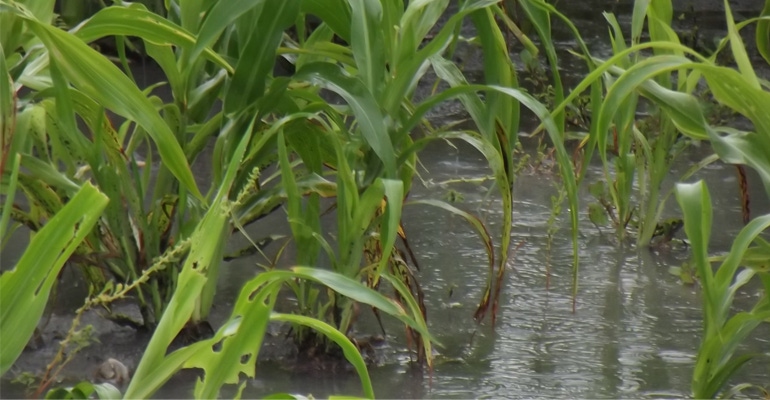June 22, 2018

Tropical weather activity in South Texas this week, including substantial rainfall accumulations of 12-15 inches in many areas, disrupted grain harvest operations, which began last week, and has left farmers unable to gain access to their fields due of flooded landscapes and muddy conditions which are expected to require several days to dry out.
Following weeks of dry conditions that resulted in severe drought for most of South Texas, long-anticipated rains finally arrived in coastal areas beginning late last week. The rain intensified rapidly in the days that followed as an upper low depression formed a tropical wave that rushed across the Gulf of Mexico and stalled over the mid-coast, bringing a constant barrage of thunderstorms for three days, resulting in regional flooding in multiple communities. Flood waters filled places like Port Aransas and Rockport, which are still undergoing recovery from Hurricane Harvey's landfall last year.
In the City of Corpus Christi and much of Nueces County, rainfall totals ranged between 10-15 inches in many locations. Similar totals were recorded in the Lower Rio Grande Valley and in Victoria and Refugio counties up the Texas coast. As of late Wednesday, June 20, Corpus Christi had received up to 12.89 inches of rain, Port Aransas and Rockport nearly 10 inches, Alice over 10 inches and Victoria just over 8-inches of rain. Heavy showers continued into Wednesday night and into Thursday, increasing those totals in some areas.
Early reports from farmers indicate many are stranded from their fields, which is especially difficult for grain sorghum producers who were harvesting fast and heavy in the days leading up to the rain event.
National Cotton Council representative for a large part of Texas, Dwight Jackson, says the much-needed rain will probably do very little for cotton fields past cut-out. But late planted and especially replanted fields may receive some benefit as the season progresses.
"Cool conditions in April caused some farmers to replant cotton and depending on the stage of development, this rain will benefit some fields. But for grain producers and some cotton farmers, the rains were too late to provide much benefit," he warns.
Jackson says after the widespread, and in some cases, devastating damages to South Texas cotton caused by Hurricane Harvey last year, there was hope this year might prove to be a good crop year. For some it may yet prove to be so, but because of severe drought areas, like Refugio County, many crops have suffered from dry conditions and even before the rains came were drought-stressed and not in the best shape.
Jackson says there were exceptions to that, like irrigated acres in the Texas Valley.
"But dryland cotton in the Valley was already in trouble, and the recent rains are not going to help those farmers," he added.
The same can be said about corn farmers up and down the Texas coast. High winds that caused lodging and an excessively dry spring growing season caused a lot of corn to wither. While there were exceptions, many farmers say their corn crops were past the hope of any recovery before the rains came.
"For farmers north of coastal areas, there is a better chance the recent rains could be beneficial," Jackson added.
For one thing, less rain fell on inland areas and on those farms, which were not under the stalled circulation of the low-pressure system. Forecasters and observers at the Corpus Christi National Weather Service (NWS) report the stalled system circulated above the Coastal Bend and the Valley regions for several days, and thunderstorms and heavy rain showers were relentless in their deluge.
NWS forecasters say a high-pressure system north of coastal regions and streaming winds from the Southwest created by Pacific storms prevented the low-pressure system and its tropical moisture-rich atmosphere from moving away from the South Texas coast for several days, creating the "perfect rain event" that was relentless with its downpours.
"Corpus Christi actually received more rain from this system than it did during Hurricane Harvey," reported KRIS-TV meteorologist Dale Nelson. "It wasn’t anything like the 50-60 inches of rain that fell over parts of Southeast Texas last year because of Hurricane Harvey. But Corpus Christi and even the Port Aransas-Rockport areas, which suffered a direct hit from the eye of the storm, received more rain in this tropical wave than they did last year."
Nelson said for the Coastal Bend, it was the Harvey’s waves and the winds that created the greatest problem, and that contrasts to the enormous cloudbursts that hit Houston and other areas of extreme Southeast Texas when Harvey made landfall and the days that followed.
Despite the heavy rains of recent days, some Coastal Bend residents say the escalating drought that was still developing before the rains finally came was worse. Tony Diaz owns a home and property adjacent to Oso Creek, a tributary that is prone to flooding neighborhoods in South Corpus Christi, land that is just a few hundred yards away from cotton and grain-rich acres of Nueces County, including Chapman Ranch.
"We were praying for rain before the rain started to fall this week, and now that conditions are improving, I'm still praying for more rain, just not all at once," Diaz told reporters watching Oso Creek waters rising at the peak of floods across the city. "We're always glad to get the rain in South Texas."
You May Also Like




